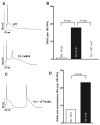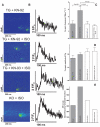Calcium/calmodulin-dependent protein kinase II contributes to cardiac arrhythmogenesis in heart failure
- PMID: 19919992
- PMCID: PMC2835502
- DOI: 10.1161/CIRCHEARTFAILURE.109.865279
Calcium/calmodulin-dependent protein kinase II contributes to cardiac arrhythmogenesis in heart failure
Abstract
Background: Transgenic (TG) Ca/calmodulin-dependent protein kinase II (CaMKII)delta(C) mice have heart failure and isoproterenol (ISO)-inducible arrhythmias. We hypothesized that CaMKII contributes to arrhythmias and underlying cellular events and that inhibition of CaMKII reduces cardiac arrhythmogenesis in vitro and in vivo.
Methods and results: Under baseline conditions, isolated cardiac myocytes from TG mice showed an increased incidence of early afterdepolarizations compared with wild-type myocytes (P<0.05). CaMKII inhibition (AIP) completely abolished these afterdepolarizations in TG cells (P<0.05). Increasing intracellular Ca stores using ISO (10(-8) M) induced a larger amount of delayed afterdepolarizations and spontaneous action potentials in TG compared with wild-type cells (P<0.05). This seems to be due to an increased sarcoplasmic reticulum (SR) Ca leak because diastolic [Ca](i) rose clearly on ISO in TG but not in wild-type cells (+20+/-5% versus +3+/-4% at 10(-6) M ISO, P<0.05). In parallel, SR Ca leak assessed by spontaneous SR Ca release events showed an increased Ca spark frequency (3.9+/-0.5 versus 2.0+/-0.4 sparks per 100 microm(-1).s(-1), P<0.05). However, CaMKII inhibition (either pharmacologically using KN-93 or genetically using an isoform-specific CaMKIIdelta-knockout mouse model) significantly reduced SR Ca spark frequency, although this rather increased SR Ca content. In parallel, ISO increased the incidence of early (54% versus 4%, P<0.05) and late (86% versus 43%, P<0.05) nonstimulated events in TG versus wild-type myocytes, but CaMKII inhibition (KN-93 and KO) reduced these proarrhythmogenic events (P<0.05). In addition, CaMKII inhibition in TG mice (KN-93) clearly reduced ISO-induced arrhythmias in vivo (P<0.05).
Conclusions: We conclude that CaMKII contributes to cardiac arrhythmogenesis in TG CaMKIIdelta(C) mice having heart failure and suggest the increased SR Ca leak as an important mechanism. Moreover, CaMKII inhibition reduces cardiac arrhythmias in vitro and in vivo and may therefore indicate a potential role for future antiarrhythmic therapies warranting further studies.
Figures






References
-
- Kirchhefer U, Schmitz W, Scholz H, Neumann J. Activity of cAMP-dependent protein kinase and Ca2+/calmodulin-dependent protein kinase in failing and nonfailing human hearts. Cardiovasc Res. 1999;42:254–261. - PubMed
-
- Hoch B, Meyer R, Hetzer R, Krause EG, Karczewski P. Identification and expression of delta-isoforms of the multifunctional Ca2+/calmodulin-dependent protein kinase in failing and nonfailing human myocardium. Circ Res. 1999;84:713–721. - PubMed
-
- Maier LS, Bers DM. Role of Ca2+/calmodulin-dependent protein kinase (CaMK) in excitation-contraction coupling in the heart. Cardiovasc Res. 2007;73:631–640. - PubMed
-
- Anderson ME, Braun AP, Wu Y, Lu T, Wu Y, Schulman H, Sung RJ. KN-93, an inhibitor of multifunctional Ca++/calmodulin-dependent protein kinase, decreases early afterdepolarizations in rabbit heart. J Pharmacol Exp Ther. 1998;287:996–1006. - PubMed
Publication types
MeSH terms
Substances
Grants and funding
LinkOut - more resources
Full Text Sources
Other Literature Sources
Medical
Research Materials
Miscellaneous

